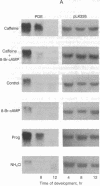Abstract
We examined expression of the Dictyostelium cAMP phosphodiesterase (PDE) gene under conditions that alter intracellular cAMP levels during in vitro differentiation of wild-type strain V12M2 and a sporogenous derivative, HB200. In control cultures, cellular PDE activity peaked at 6 hr and declined by 8 hr, while secreted PDE activity continued to increase through 8 hr. Lowering intracellular cAMP levels with caffeine or progesterone increased cellular and secreted PDE activities 2-fold, increased stalk cell differentiation, and inhibited spore differentiation. In contrast, exposure to 8-bromoadenosine 3',5'-cyclic monophosphate (8-Br-cAMP; a membrane-permeable cAMP analog) or ammonia (which promotes intracellular cAMP accumulation in V12M2 and HB200 cells) lowered PDE activities by as much as 45%, decreased stalk cell differentiation, and increased spore differentiation. Simultaneous exposure to 8-Br-cAMP and caffeine gave intermediate PDE activities as would be expected if 8-Br-cAMP entered the cell and bypassed the caffeine-mediated block to adenylate cyclase activation. In all cases, we observed commensurate changes in developmental PDE transcript levels. The developmental time course of expression was not significantly altered by these treatments. These results suggest that the magnitude of PDE gene expression is negatively regulated by intracellular cAMP levels and provide evidence for one of the earliest changes in gene expression that is consistent with cell-type specificity. These results are discussed in terms of a bistable switch employing intracellular cAMP as a regulator of cell fate.
Full text
PDF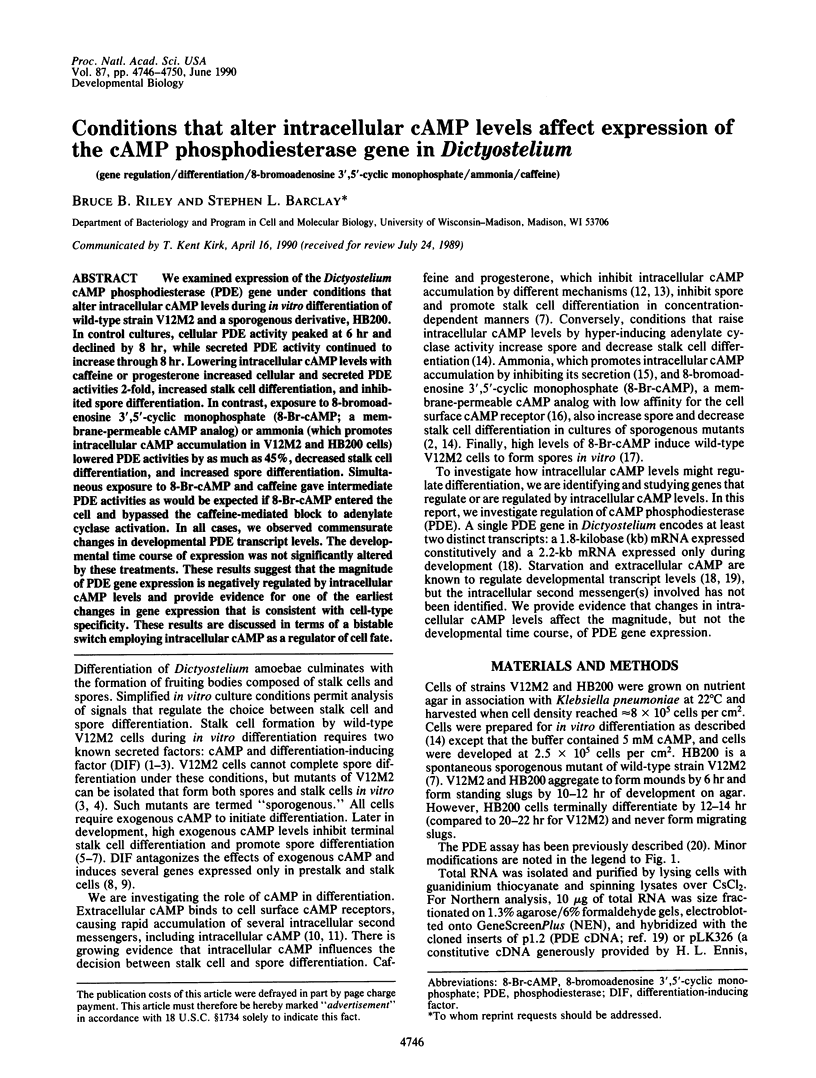
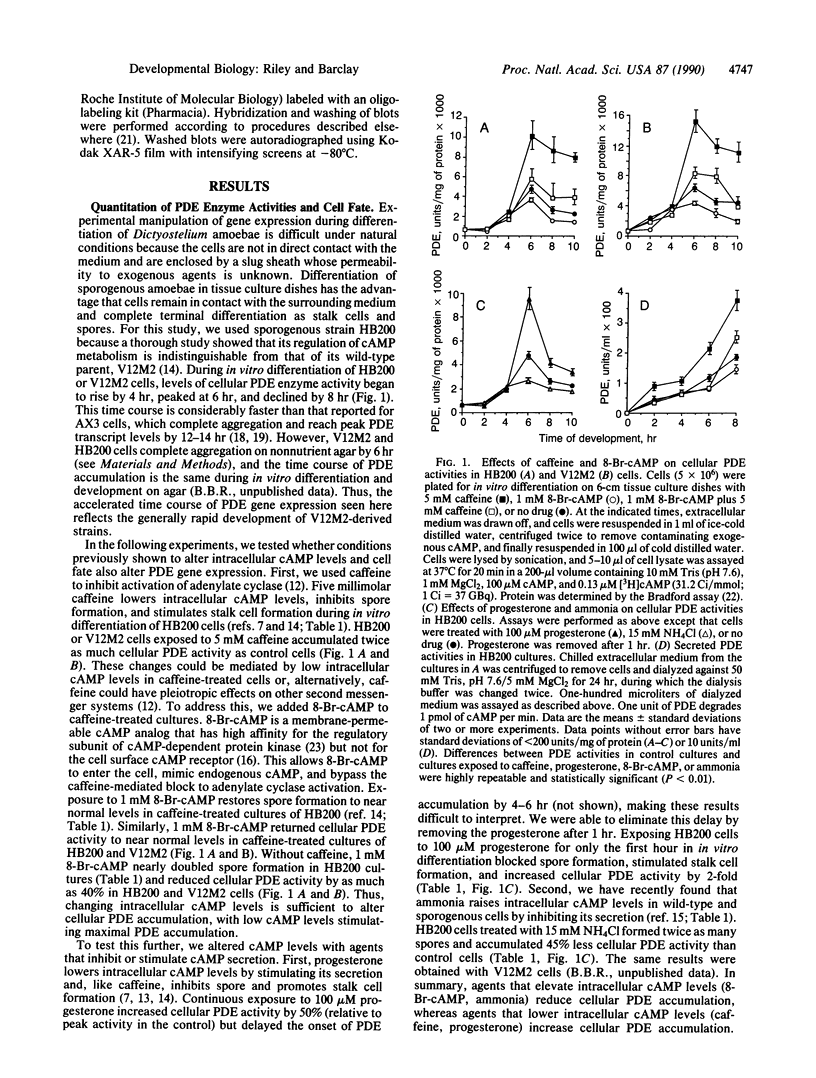
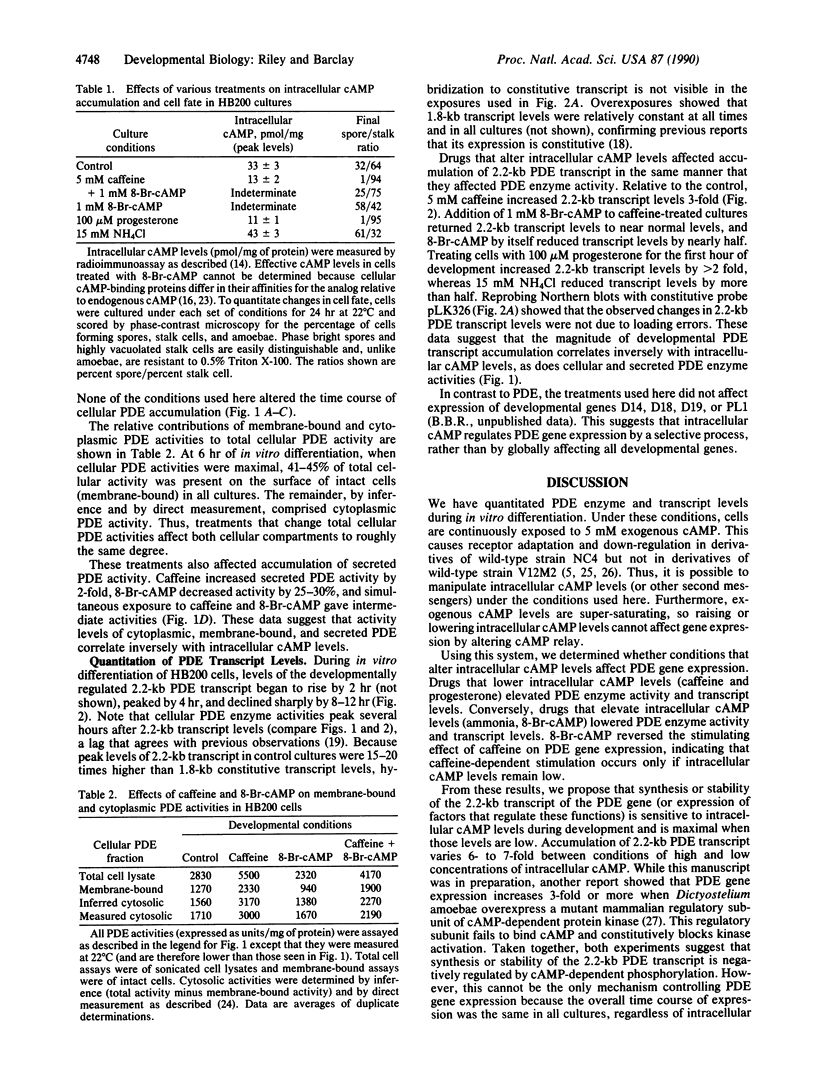
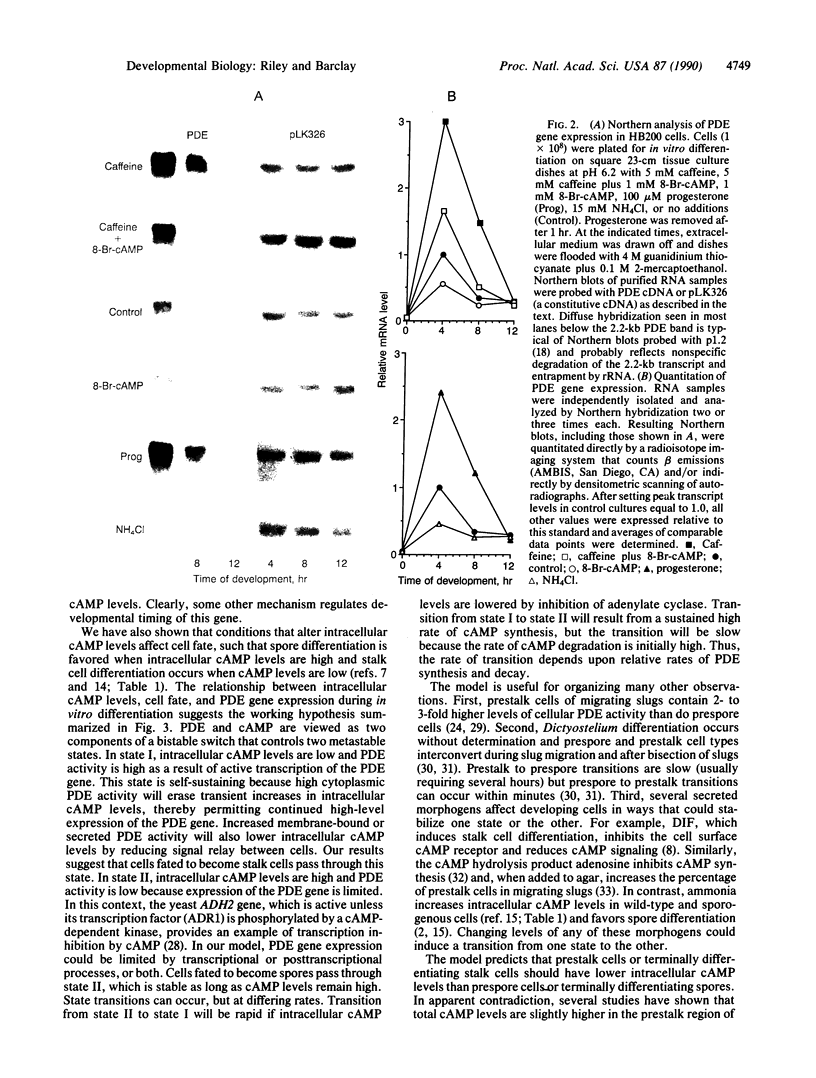
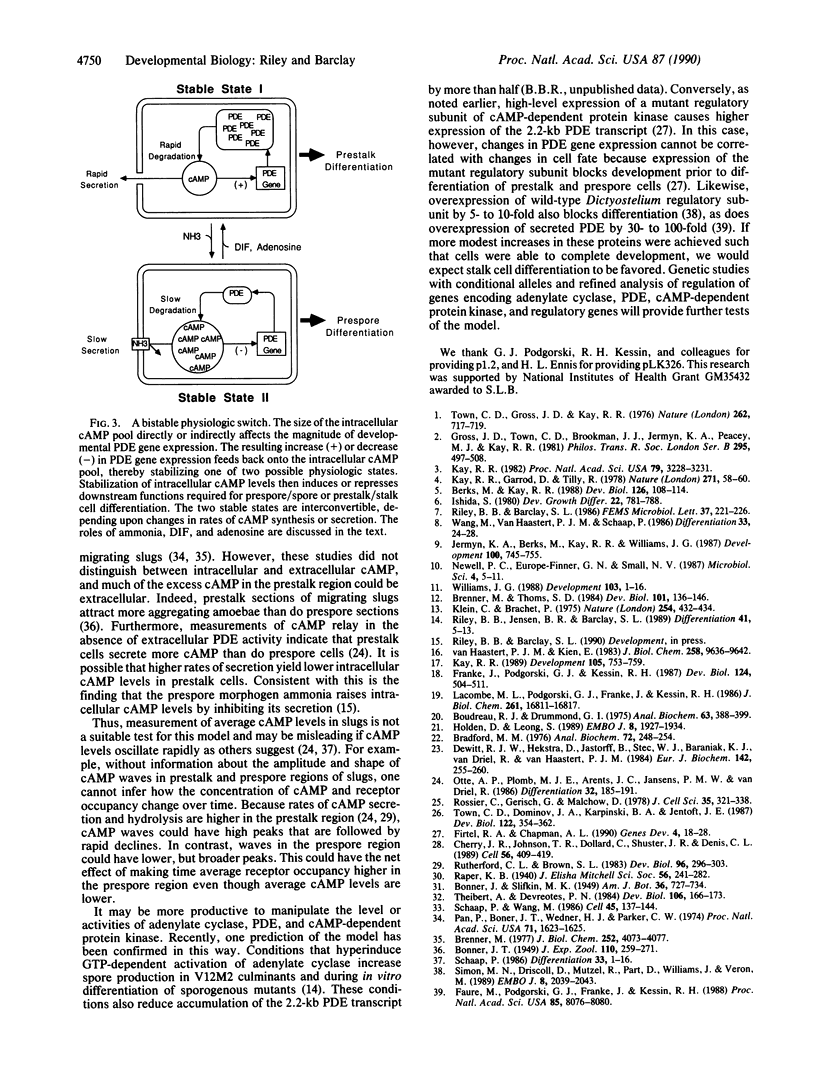
Images in this article
Selected References
These references are in PubMed. This may not be the complete list of references from this article.
- Berks M., Kay R. R. Cyclic AMP is an inhibitor of stalk cell differentiation in Dictyostelium discoideum. Dev Biol. 1988 Mar;126(1):108–114. doi: 10.1016/0012-1606(88)90244-8. [DOI] [PubMed] [Google Scholar]
- Boudreau R. J., Drummond G. I. A modified assay of 3':5'-cyclic-AMP phosphodiesterase. Anal Biochem. 1975 Feb;63(2):388–399. doi: 10.1016/0003-2697(75)90361-9. [DOI] [PubMed] [Google Scholar]
- Bradford M. M. A rapid and sensitive method for the quantitation of microgram quantities of protein utilizing the principle of protein-dye binding. Anal Biochem. 1976 May 7;72:248–254. doi: 10.1006/abio.1976.9999. [DOI] [PubMed] [Google Scholar]
- Brenner M. Cyclic AMP gradient in migrating pseudoplasmodia of the cellular slime mold Dictyostelium discoideum. J Biol Chem. 1977 Jun 25;252(12):4073–4077. [PubMed] [Google Scholar]
- Brenner M., Thoms S. D. Caffeine blocks activation of cyclic AMP synthesis in Dictyostelium discoideum. Dev Biol. 1984 Jan;101(1):136–146. doi: 10.1016/0012-1606(84)90124-6. [DOI] [PubMed] [Google Scholar]
- Cherry J. R., Johnson T. R., Dollard C., Shuster J. R., Denis C. L. Cyclic AMP-dependent protein kinase phosphorylates and inactivates the yeast transcriptional activator ADR1. Cell. 1989 Feb 10;56(3):409–419. doi: 10.1016/0092-8674(89)90244-4. [DOI] [PubMed] [Google Scholar]
- Faure M., Podgorski G. J., Franke J., Kessin R. H. Disruption of Dictyostelium discoideum morphogenesis by overproduction of cAMP phosphodiesterase. Proc Natl Acad Sci U S A. 1988 Nov;85(21):8076–8080. doi: 10.1073/pnas.85.21.8076. [DOI] [PMC free article] [PubMed] [Google Scholar]
- Firtel R. A., Chapman A. L. A role for cAMP-dependent protein kinase A in early Dictyostelium development. Genes Dev. 1990 Jan;4(1):18–28. doi: 10.1101/gad.4.1.18. [DOI] [PubMed] [Google Scholar]
- Franke J., Podgorski G. J., Kessin R. H. The expression of two transcripts of the phosphodiesterase gene during the development of Dictyostelium discoideum. Dev Biol. 1987 Dec;124(2):504–511. doi: 10.1016/0012-1606(87)90503-3. [DOI] [PubMed] [Google Scholar]
- Gross J. D., Town C. D., Brookman J. J., Jermyn K. A., Peacey M. J., Kay R. R. Cell patterning in Dictyostelium. Philos Trans R Soc Lond B Biol Sci. 1981 Oct 7;295(1078):497–508. doi: 10.1098/rstb.1981.0156. [DOI] [PubMed] [Google Scholar]
- Holden D. W., Kronstad J. W., Leong S. A. Mutation in a heat-regulated hsp70 gene of Ustilago maydis. EMBO J. 1989 Jul;8(7):1927–1934. doi: 10.1002/j.1460-2075.1989.tb03596.x. [DOI] [PMC free article] [PubMed] [Google Scholar]
- Jermyn K. A., Berks M., Kay R. R., Williams J. G. Two distinct classes of prestalk-enriched mRNA sequences in Dictyostelium discoideum. Development. 1987 Aug;100(4):745–755. doi: 10.1242/dev.100.4.745. [DOI] [PubMed] [Google Scholar]
- Kay R. R., Garrod D., Tilly R. Requirement for cell differentiation in Dictyostelium discoideum. Nature. 1978 Jan 5;271(5640):58–60. doi: 10.1038/271058a0. [DOI] [PubMed] [Google Scholar]
- Kay R. R. cAMP and spore differentiation in Dictyostelium discoideum. Proc Natl Acad Sci U S A. 1982 May;79(10):3228–3231. doi: 10.1073/pnas.79.10.3228. [DOI] [PMC free article] [PubMed] [Google Scholar]
- Klein C., Brachet P. Effects of progesterone and EDTA on cyclic AMP and phosphodiesterase in Dictyostelium discoideum. Nature. 1975 Apr 3;254(5499):432–434. doi: 10.1038/254432a0. [DOI] [PubMed] [Google Scholar]
- Lacombe M. L., Podgorski G. J., Franke J., Kessin R. H. Molecular cloning and developmental expression of the cyclic nucleotide phosphodiesterase gene of Dictyostelium discoideum. J Biol Chem. 1986 Dec 25;261(36):16811–16817. [PubMed] [Google Scholar]
- Newell P. C., Europe-Finner G. N., Small N. V. Signal transduction during amoebal chemotaxis of Dictyostelium discoideum. Microbiol Sci. 1987 Jan;4(1):5–11. [PubMed] [Google Scholar]
- Otte A. P., Plomp M. J., Arents J. C., Janssens P. M., van Driel R. Production and turnover of cAMP signals by prestalk and prespore cells in Dictyostelium discoideum cell aggregates. Differentiation. 1986;32(3):185–191. doi: 10.1111/j.1432-0436.1986.tb00572.x. [DOI] [PubMed] [Google Scholar]
- Pan P., Bonner J. T., Wedner H. Y., Parker C. W. Immunofluorescence evidence for the distribution of cyclic AMP in cells and cell masses of the cellular slime molds. Proc Natl Acad Sci U S A. 1974 May;71(5):1623–1625. doi: 10.1073/pnas.71.5.1623. [DOI] [PMC free article] [PubMed] [Google Scholar]
- Riley B. B., Jensen B. R., Barclay S. L. Conditions that elevate intracellular cyclic AMP levels promote spore formation in Dictyostelium. Differentiation. 1989 Jul;41(1):5–13. doi: 10.1111/j.1432-0436.1989.tb00726.x. [DOI] [PubMed] [Google Scholar]
- Rossier C., Gerisch G., Malchow D. Action of a slowly hydrolysable cyclic AMP analogue on developing cells of Dictyostelium discoideum. J Cell Sci. 1979 Feb;35:321–338. doi: 10.1242/jcs.35.1.321. [DOI] [PubMed] [Google Scholar]
- Rutherford C. L., Brown S. S. Cell type specific inhibition of cAMP phosphodiesterase activity during terminal differential in Dictyostelium discoideum. Dev Biol. 1983 Apr;96(2):296–303. doi: 10.1016/0012-1606(83)90166-5. [DOI] [PubMed] [Google Scholar]
- Schaap P., Wang M. Interactions between adenosine and oscillatory cAMP signaling regulate size and pattern in Dictyostelium. Cell. 1986 Apr 11;45(1):137–144. doi: 10.1016/0092-8674(86)90545-3. [DOI] [PubMed] [Google Scholar]
- Simon M. N., Driscoll D., Mutzel R., Part D., Williams J., Véron M. Overproduction of the regulatory subunit of the cAMP-dependent protein kinase blocks the differentiation of Dictyostelium discoideum. EMBO J. 1989 Jul;8(7):2039–2043. doi: 10.1002/j.1460-2075.1989.tb03612.x. [DOI] [PMC free article] [PubMed] [Google Scholar]
- Theibert A., Devreotes P. N. Adenosine and its derivatives inhibit the cAMP signaling response in Dictyostelium discoideum. Dev Biol. 1984 Nov;106(1):166–173. doi: 10.1016/0012-1606(84)90072-1. [DOI] [PubMed] [Google Scholar]
- Town C. D., Dominov J. A., Karpinski B. A., Jentoft J. E. Relationships between extracellular pH, intracellular pH, and gene expression in Dictyostelium discoideum. Dev Biol. 1987 Aug;122(2):354–362. doi: 10.1016/0012-1606(87)90300-9. [DOI] [PubMed] [Google Scholar]
- Town C. D., Gross J. D., Kay R. R. Cell differentiation without morphogenesis in Dictyostelium discoideum. Nature. 1976 Aug 19;262(5570):717–719. doi: 10.1038/262717a0. [DOI] [PubMed] [Google Scholar]
- Van Haastert P. J., Kien E. Binding of cAMP derivatives to Dictyostelium discoideum cells. Activation mechanism of the cell surface cAMP receptor. J Biol Chem. 1983 Aug 25;258(16):9636–9642. [PubMed] [Google Scholar]
- Williams J. G. The role of diffusible molecules in regulating the cellular differentiation of Dictyostelium discoideum. Development. 1988 May;103(1):1–16. [PubMed] [Google Scholar]
- de Wit R. J., Hekstra D., Jastorff B., Stec W. J., Baraniak J., Van Driel R., Van Haastert P. J. Inhibitory action of certain cyclophosphate derivatives of cAMP on cAMP-dependent protein kinases. Eur J Biochem. 1984 Jul 16;142(2):255–260. doi: 10.1111/j.1432-1033.1984.tb08279.x. [DOI] [PubMed] [Google Scholar]



